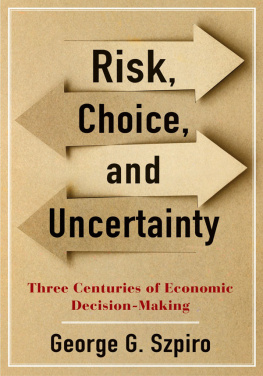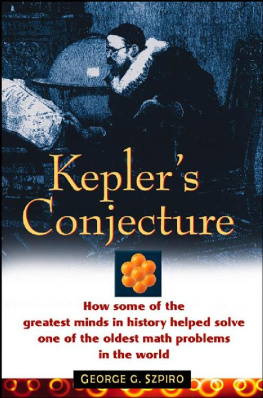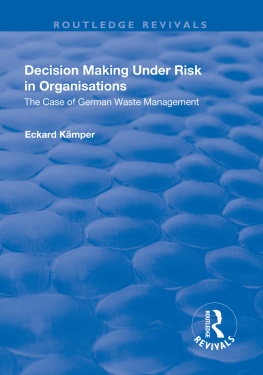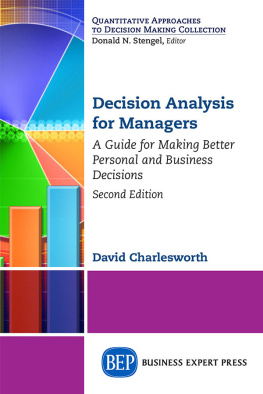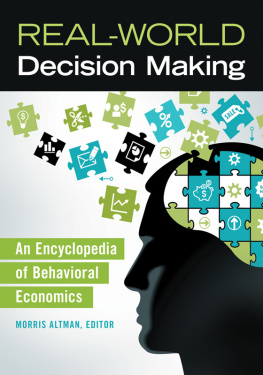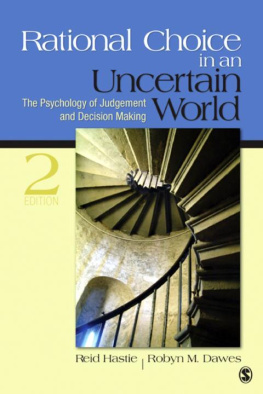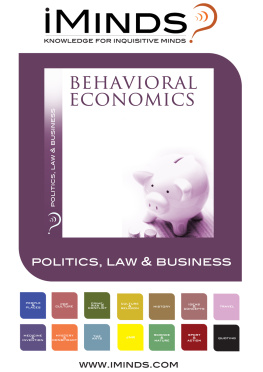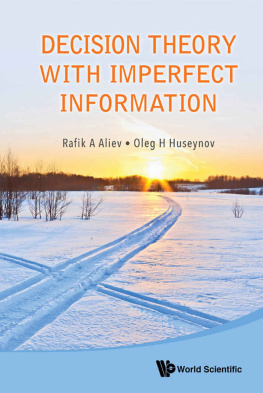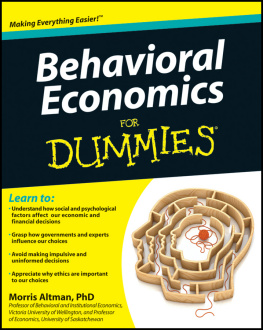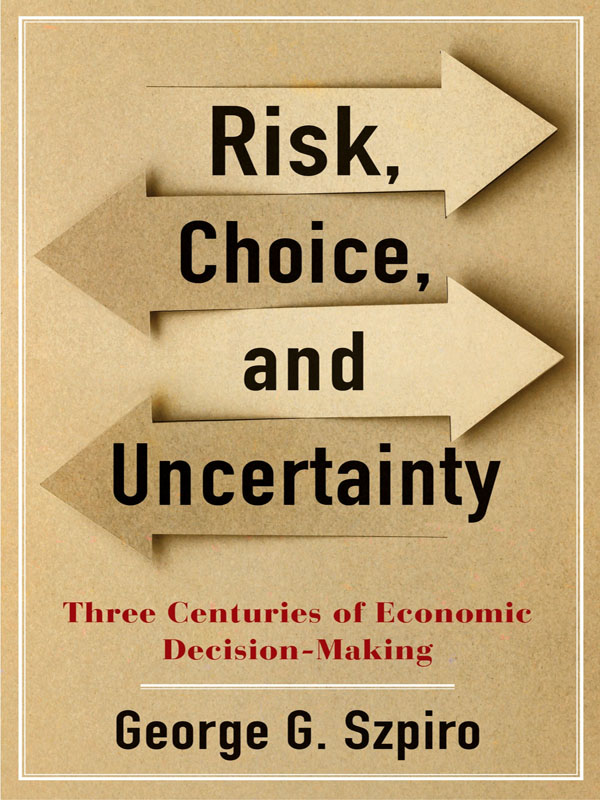Table of Contents
RISK, CHOICE, AND UNCERTAINTY
RISK, CHOICE, AND UNCERTAINTY
THREE CENTURIES OF ECONOMIC DECISION-MAKING
George Szpiro
COLUMBIA UNIVERSITY PRESS
NEW YORK
Columbia University Press
Publishers Since 1893
New York Chichester, West Sussex
cup.columbia.edu
Copyright 2020 Columbia University Press
All rights reserved
E-ISBN 978-0-231-55097-0
Library of Congress Cataloging-in-Publication Data
Names: Szpiro, George, 1950 author.
Title: Risk, choice, and uncertainty: three centuries of economic decision-making / George G. Szpiro.
Description: New York: Columbia University Press, 2019. | Series: Risky decisions | Includes bibliographical references and index.
Identifiers: LCCN 2019023645 (print) | LCCN 2019023646 (e-book) | ISBN 9780231194747 (cloth) | ISBN 9780231550970 (e-book)
Subjects: LCSH: Decision making. | Risk management.
Classification: LCC HD30.23 .S97 2019 (print) | LCC HD30.23 (e-book) | DDC 330.01/9dc23
LC record available at https://lccn.loc.gov/2019023645
LC e-book record available at https://lccn.loc.gov/2019023646
A Columbia University Press E-book.
CUP would be pleased to hear about your reading experience with this e-book at .
Cover design: Noah Arlow
Cover image: Jorg Greuel/Getty Images
This book is dedicated to Tamar, Rotem and Daniel and to all who will follow.
CONTENTS
T wo schools of Jewish thought prevailed in the first century BCE, led by Rabbi Hillel and Rabbi Shammai, respectively. The Talmud tells that the latter was strict and impatient and had a short temper, while Hillel was gentle and conciliatory. One day, a stranger came to Shammai and asked to be converted to Judaism. He was in a great hurry and demanded: Make me a Jew on condition that you teach me the whole Torah while I stand on one foot. What nerve! Not yet Jewish, and already showing such chutzpah! Incensed, Shammai hit the man with a cane and threw him out of his house. Unperturbed, the stranger went to Hillel to try his luck with him. Calmly, Hillel took up the challenge. While the insolent would-be Jew stood on one foot, the rabbi declared: What is hateful to you, do not do unto others. That is the whole Torah; all the rest is commentary. Now go and study.
Why do I tell this anecdote? Well, economics is similar: People prefer more of a good, but the more they already have, the less they value each additional unit. Thats the whole of economics; all the rest is commentary. Now go and read.
The fact that people prefer to possess more of nearly everything, but that they do so at a decreasing rate, already had been observed by the ancient Greeks. Much later, in the eighteenth century, the mathematician Daniel Bernoulli, then teaching in St. Petersburg in Russia, used this knowledge to propose a solution to a gambling problem posed by his cousin Nikolaus. The ingenious solution that he andindependentlyhis fellow mathematician Gabriel Cramer proposed was based precisely on the fact that the utility of wealth (i.e., its enjoyment) diminishes as wealth increases. After all, an additional dollar offers more utility to a homeless beggar than to a millionaire.
For these mathematicians, the St. Petersburg Paradox represented nothing more than an interesting problem about games of chance; they drew no connection between the mathematical conundrum and economics. Indeed, eighteenth-century economics was mostly about casual observations. Adam Smith, for example, who laid the foundations of classical economics, introduced the notions of division of labor and economies of scale by describing work in a needle factory. Early economists did suggest models of the economy. However, apart from arithmetic illustrations and examples, their work consisted mainly of words: They described their observations, recounted anecdotes, and explained their conclusions.
Thus, compared to, say, physics, medicine, or chemistry, economics was not considered a serious sciencenot until mathematics entered the scene, anyway. The discipline turned into a serious science only after mathematical models were developed that suggested how to optimize something, be it wealth, profits, or the utility for money. This occurred only in the late nineteenth century, when neoclassical economists began to utilize mathematical methodology and tools. (When Alfred Nobel established the Nobel prizes in 1895, economics was not among the sciences honored.)
Here is where the Bernoulli family comes in once again. Apart from providing a solution to the St. Petersburg Paradox, Daniel Bernoulli and several other members of his illustrious family of scientists were pioneers in the application of infinitesimal calculus, the mathematical techniques that had been developed by Isaac Newton and Gottfried Wilhelm Leibniz to study the continuous change of physical objects (i.e., the paths of stars and moving objects). In the late nineteenth century, three economists working independently of each otherStanley Jevons in England, Lon Walras in Switzerland, and Carl Menger in Austriabegan to apply calculus to economic science. With this, the mathematization of economics began, and a very fruitful period for the discipline ensued. But over time, the mathematics that were employed became more and more sophisticated, and eventually academic papers in economics were barely distinguishable from research in the mathematical sciences. Economics had nearly turned into a branch of pure mathematics.
This changed again in the late twentieth century, with the emergence of behavioral economics. After about the 1970s, the discipline adopted a much more behavior-oriented approach. Thus, during the past half-century or so, the aim has become to describe how people actually behave, with the discipline relying more on psychology and less on mathematics. (To wit: in the early decades after the institution of the Nobel Prize in Economics in 1968, the prize was awarded only for mathematical theories; but lately, it has been fashionable to award it for nonmathematical models.)
This book is about how people make decisions. And because decision-making underlies most, if not all, of economics, the book presents a novel approach to the history of economic thought.
It is divided into three parts. , which covers the developments and the personalities of the latter part of the twentieth century until today, describes how human beings actually do act (i.e., positive economics). It turns out that, in general, people are not rational. Hence, the beautiful mathematical models are largely ignored, and psychology is the name of the game.
The viewpoint of this book is not that economics has become too mathematically oriented and that a backlash is occurring. On the contrarymathematics is, and must remain, the basis for normative economicsthat is, how decisions should be made. And the behavioral models, in fact, also rely on mathematics.
However, when describing how people actually make decisions, mathematics becomes less prominent. According to a recent Nobel laureate in economics, Richard Thaler, as well as others, it is precisely the limits to decision-makers computational abilities and their ignorance of the normative models that make humans seem irrational.

